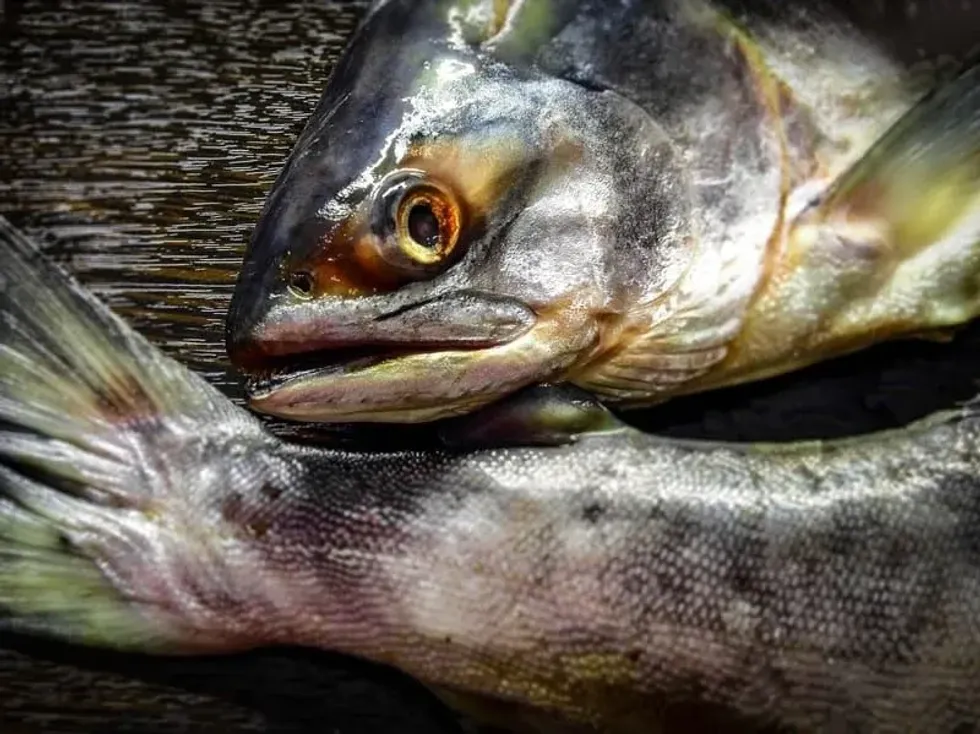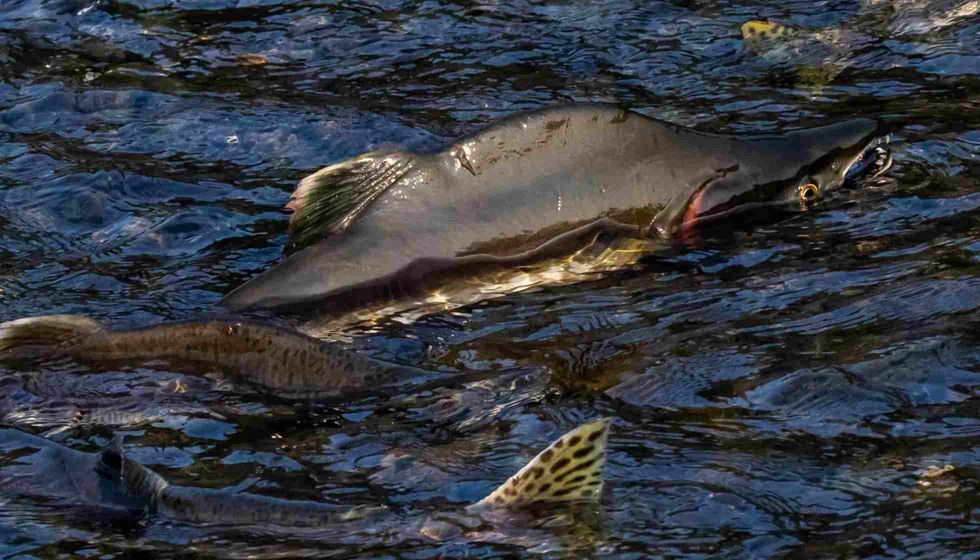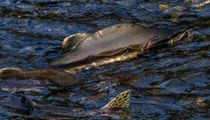Fun Pink Salmon Facts For Kids

Having gained popularity in recent times, the pink salmon is arguably one of the most important Pacific salmon fish for fisheries in the United States of America and some other countries in the world.
However, beyond being sustenance for humans, the pink salmon is actually an important part of its ecosystem.
Not only do the Pacific salmon serve as prey for other fish such as the killer whale but also for some land animals such as bears in the wild near rivers, where pink salmon have been found to migrate.
With its peculiar spawning patterns, the pink salmon population could crash abruptly without humans being able to prevent it from happening.
The population of this freshwater Pacific salmon fish species can be primarily found in the Arctic Ocean and the Pacific Ocean as well as the connected river systems.
Pink salmon are unique in the sense that these ocean fish only have a two-year lifespan. These fish of North America can be found in various streams and rivers ranging from northern California to the Mackenzie River.
Keep reading and learning to find out more about this popular humpback freshwater salmon fish! After checking out these fascinating facts about the Alaska pink salmon, do check out our other articles on Dover sole facts and king mackerel facts as well.
Pink Salmon Interesting Facts
What type of animal is a pink salmon?
The pink salmon is a carnivorous fish with a white belly. However, a Pacific salmon is not at the top of the food chain in its habitat in freshwater. It is a popular fish species amongst anglers who like fishing in open waters.
What class of animal does a pink salmon belong to?
The pink salmon belongs to the class of humpback salmon fish and is classified as part of Actinopterygii, owing to the fact that these ocean fish have ray fins and bony structures.
How many pink salmon are there in the world?
It is difficult and nearly impossible to put a number on the number of pink Pacific salmon in the world due to their erratic reproduction habits. However, in places like California and Alaska, the species of pink salmon have been known to dwindle due to the rampant issues of excessive fishing for commercial purposes.
In these territories, pink salmon have been classified as an endangered species in need of conservation efforts.
Where does a pink salmon live?
Pink salmon populations in North America typically live in freshwater bodies, oceans, and seas and only sometimes travel upstream to rivers for the purposes of spawning. In general, pink salmon prefer freshwater bodies that have lower temperatures.
What is a pink salmon's habitat?
Pink salmon's habitat is typically oceans and seas and they only sometimes travel upstream to freshwater rivers for the purposes of spawning. In general, pink salmon populations prefer waters that have lower temperatures.
The ideal temperature for this humpback salmon is around 50 degrees Fahrenheit (10 °C), and these fish can die at temperatures above 77 degrees Fahrenheit (25 °C).
Who do pink salmon live with?
Pink salmon are typically found in shoals with other salmon species. In the oceans, this species of fish lives with other fish of the same size or sometimes even bigger.
This North Pacific food fish species prey on zooplankton and marine invertebrate creatures. Bigger fish such as killer whales and some different species of birds, and in freshwater streams or rivers, bears and other mammals feed on these fish.
How long does a pink salmon live?
The average life expectancy of a pink salmon is around two years of age in the sea. However, the reason for this is that pink salmon typically spawn at the age of two and all of them usually die after they spawn.
The large rivers are dangerous when it comes to climate change, affecting the lifespan of this species in North America.
How do they reproduce?
Pink salmon are fish in the sea that enter freshwater streams and rivers to reproduce, and these streams and rivers, or seas, are usually the places where they were born. Their principal spawning areas are between Puget Sound, Washington, and Bristol Bay, Alaska.
Having come back to their native streams, adult pink salmon, in the months of June through October, reproduce.
Female pink salmon make use of their tails to dig nests in the gravel on the ground which are shaped like containers and are called redds.
Having dug a redd, they lay their eggs into these nests and wait for a male pink salmon who wishes to fertilize her eggs. These males fertilize the female’s eggs while they are being deposited into the redd.
One female can mate with multiple males when spawning since she lays around 1000 eggs to 2000 in multiple clutches, and once these eggs are fertilized, the female pink salmon use their tails to cover up their nests. Female pink salmon usually protect their fertilized eggs until they die of exhaustion after having laid in excess of 1000 eggs.
She dies protecting these young pink salmon fish after a mere few days of laying her eggs.
What is their conservation status?
The pink salmon is only classified as critically endangered by NatureServe, in some areas, including California and Washington, due to overfishing practices and commercial use. However, in most other areas, due to healthy fishing practices and conservation efforts, the population of pink salmon is considered to be in healthy numbers.
This species of fish is, however, not listed on the IUCN Red List under any classification.
Pink Salmon Fun Facts
What do pink salmon look like?

Pink salmon males are one of the smallest species of salmon in the whole world. However, in their spawning streams, pink salmon can be identified by their grayish colors or excessively dull colors with a white belly and irregular-shaped dark spots.
Further, typical characteristics of the pink salmon include big oval patches all across their backs, white mouths and black gums, and anal fins, and white belly.
It is only during spawning that this species develops a large hump that is typically more noticeable in males as compared to a female pink salmon. Young pink salmon are completely silver in appearance without any dark black spots.
How cute are they?
Pink salmon are fairly cute when found in freshwater streams and rivers since this is usually where these freshwater fish are found in spawning seasons. When these fish spawn, they develop a large hump on their backs which can be seen as an amusing feature that makes them look cute.
Their beautiful hues of silver and grey look very pretty when in sea or ocean waters.
How do they communicate?
Empirical observations show us that they may be using auditory and visual cues to communicate with one another by emitting a Puget sound. A Puget sound is made in the water by a fish.
How big is a pink salmon?
The pink salmon is, on average, 20-25 in (50-63 cm) long and about 3.5-5 lb (1.5-2.2 kg) in weight. In general, a pink salmon can be as big, or a little bigger than, an average human being’s forearm.
How fast can a pink salmon swim?
A pink salmon is known to have a pace of 1.12 mph (4.03 kph) when it comes to swimming speed. It can increase its speed as well if the circumstances require so.
How much does a pink salmon weigh?
A pink salmon usually only grows to 3.5-5 lb (1.5-2.2 kg) in weight, on average. However, the heaviest pink salmon recorded to date weighed about 15 lb (6.8 kg).
What are the male and female names of the species?
No individual names have been assigned to the members of this freshwater species. They are simply referred to by their generic species name, pink salmon. Males are known as male pink salmons, while females are referred to as female pink salmons.
What would you call a baby pink salmon?
A baby pink salmon is typically called a pink salmon fry. Young pink salmon fry act as prey to various large fish species in the North Pacific.
As the body of pink salmon babies has no dark spots, they are able to camouflage in the streams and be safe from predators.
Young fry enter the water as soon as they are born but before entering the ocean water directly, they school in estuaries, and only after several months do they enter the Pacific Ocean or the Arctic Ocean.
What do they eat?
Pink salmon are predatory fish. However, this North Pacific food fish does not lie at the top of their food chain. These fish typically feed on zooplankton, marine invertebrate creatures, and some smaller species of fish. The pink salmon diet revolves around fish.
Are they dangerous?
As live fish, this ocean fish hasn’t been reported to be dangerous to humans. However, when eating pink salmon as food, one must be careful to check for tapeworms.
Would they make a good pet?
No, pink salmon would not make for good pets since these North Pacific Ocean food fish are almost 2 ft (0.6 m) long, and keeping two feet long fish in an aquarium would require a massive one. Moreover, these fish aren’t typically interactive with humans and like to travel long distances.
Another disadvantage is that this species of fish only lives for about two years after which they spawn in order to reproduce, and they require multiple reproductive partners which are nearly impossible to arrange in an aquarium.
Did you know...
The largest type of salmon in the world is the Atlantic salmon.
Salmon, in general, are referred to as anadromous fish because of their reproductive behavior, wherein they only spawn in freshwater streams and rivers as an added protection against other predatory marine creatures. But sometimes, pink salmon spawn right in saltwater, avoiding freshwater
Each individual pink salmon typically returns to spawn in the river where it hatched.
Do people eat pink salmon?
Yes, pink salmon, along with other species of salmon, are often consumed by human beings all over the globe. The most popular way of eating pink salmon is as a canned food wherein salmon is mashed along with the bones.
Some people prefer salmon as fillets or grilled salmon. Pink salmon is consumed by people due to its rich nutritional profile that is known for healthy protein contents and healthy fats that have been known to combat diabetes and heart diseases.
Differences between pink salmon and red salmon
The first and foremost difference between pink salmon and red salmon is the species to which they both belong. Red salmon belong to the species called sockeye salmon, whereas pink salmon is a different species by itself.
Moreover, red salmon is so-called due to the change in its color that usually occurs after spawning.
Pink salmon have been known to look very similar to tuna. Apart from this, the sockeye or red salmon is a freshwater or river water fish, whereas the pink salmon only migrate to freshwater streams or rivers for the purposes of spawning.
Here at Kidadl, we have carefully created lots of interesting family-friendly animal facts for everyone to discover! Learn more about some other fish including king salmon facts, or Kokanee salmon facts.
You can even occupy yourself at home by coloring in one of our free printable Pink Salmon coloring pages.
We Want Your Photos!
More for You
See All
Bachelor of Science specializing in Mass Communication.

Adekunle Olanrewaju JasonBachelor of Science specializing in Mass Communication.
Bachelor of Arts specializing in Economics

Gowri RaoBachelor of Arts specializing in Economics
With a bachelor's degree in Economics from Krea University, Gowri is a highly skilled data analyst and an expert in regression and causation modeling. Her interests in economic trends, finance, and investment research complement her professional expertise. In addition to her professional pursuits, Gowri enjoys swimming, running, and playing the drums, and she is also a talented tutor.
Disclaimer
1) Kidadl is independent and to make our service free to you the reader we are supported by advertising. We hope you love our recommendations for products and services! What we suggest is selected independently by the Kidadl team. If you purchase using the Buy Now button we may earn a small commission. This does not influence our choices. Prices are correct and items are available at the time the article was published but we cannot guarantee that on the time of reading. Please note that Kidadl is a participant in the Amazon Services LLC Associates Program, an affiliate advertising program designed to provide a means for sites to earn advertising fees by advertising and linking to Amazon. We also link to other websites, but are not responsible for their content.
2) At Kidadl, we strive to recommend the very best activities and events. We will always aim to give you accurate information at the date of publication - however, information does change, so it’s important you do your own research, double-check and make the decision that is right for your family. We recognise that not all activities and ideas are appropriate for all children and families or in all circumstances. Our recommended activities are based on age but these are a guide. We recommend that these ideas are used as inspiration, that ideas are undertaken with appropriate adult supervision, and that each adult uses their own discretion and knowledge of their children to consider the safety and suitability. Kidadl cannot accept liability for the execution of these ideas, and parental supervision is advised at all times, as safety is paramount. Anyone using the information provided by Kidadl does so at their own risk and we can not accept liability if things go wrong.
3) Because we are an educational resource, we have quotes and facts about a range of historical and modern figures. We do not endorse the actions of or rhetoric of all the people included in these collections, but we think they are important for growing minds to learn about under the guidance of parents or guardians.







